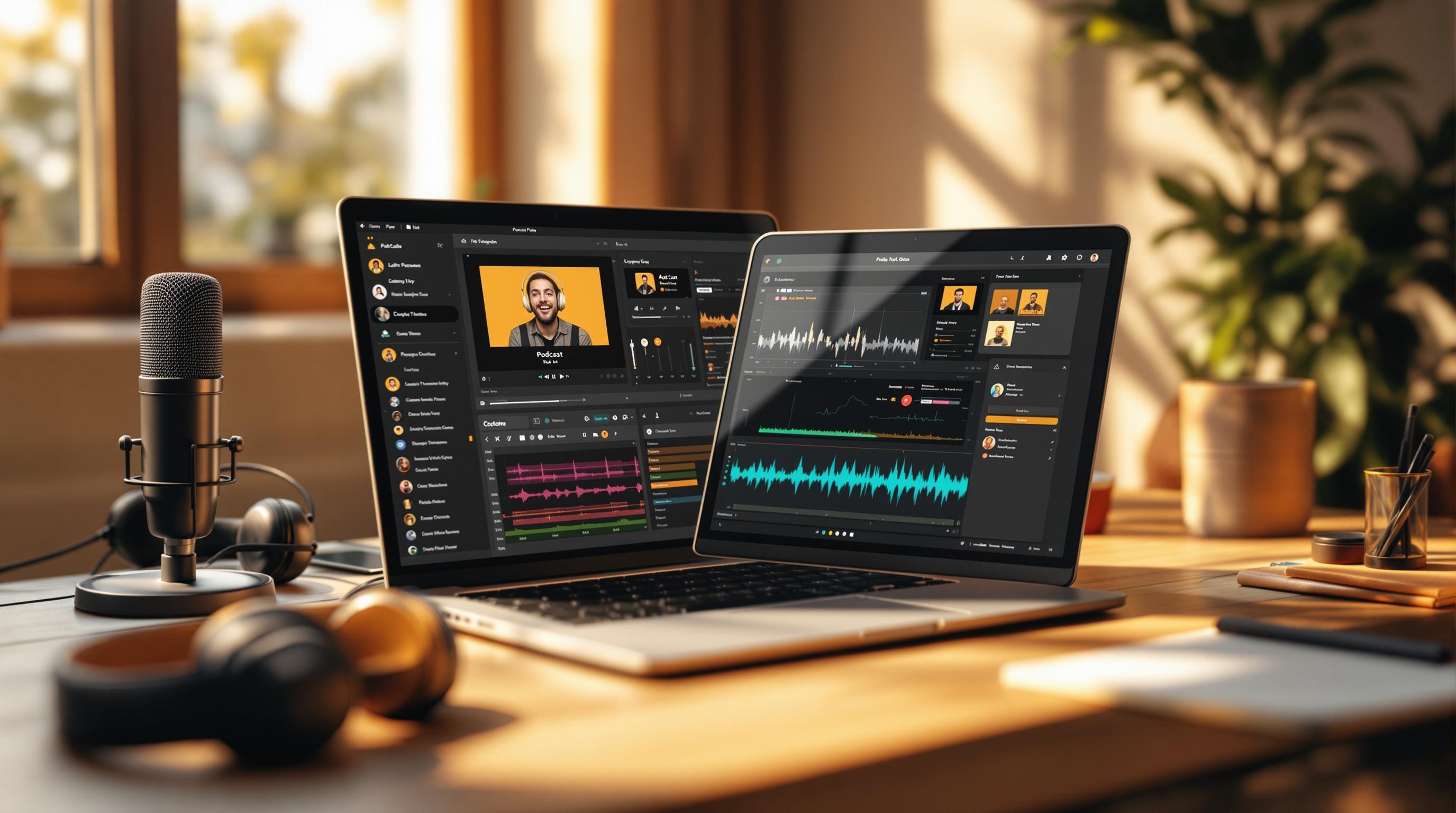In 2024, the creator economy is booming, offering numerous opportunities for influencers to grow their audience and monetize their content. This article highlights the essential tools and trends shaping the influencer landscape:
- Content Creation Tools like Canva, Biteable, and Animoto simplify designing engaging posts and videos.
- Analytics Platforms such as SocialBlade and Iconosquare provide valuable insights into audience engagement and growth.
- Monetization Platforms including Patreon, Buy Me a Coffee, and TapeReal offer new ways to earn directly from content.
- Community Building Tools like Discord and Mighty Networks help influencers manage and grow their private communities.
Additionally, we explore key trends:
- Diversification of Revenue Streams: Influencers are exploring various income sources beyond ads.
- Rise of Micro-Influencers: Brands value the high engagement rates of influencers with smaller, niche audiences.
- Authenticity and Niche Content: Genuine content tailored to specific interests resonates more with audiences.
- Increased Use of AI and Automation: These technologies streamline content creation and audience engagement.
Challenges such as platform dependency, maintaining relevance, achieving work-life balance, and dealing with harassment also play a significant role in the influencer's journey. Despite these, the future of the creator economy looks promising, with growing opportunities for those ready to adapt and innovate.
What is the Creator Economy?
The creator economy is all about people making money online by creating and sharing stuff like videos, blog posts, or podcasts. It includes:
- Creators: These are the folks who make content. They could be anyone from the person making makeup tutorials on YouTube to the one sharing travel photos on Instagram.
- Platforms: Places like YouTube, Instagram, TikTok, and Patreon where creators post their work, grow their audience, and earn money.
- How They Make Money: There are many ways creators can earn cash, like through ads, working with brands, selling stuff, or getting support from fans.
This world of online content creation lets people make a living by doing what they enjoy, from sharing knowledge to showing off skills or passions.
The Role of Influencers
Influencers are creators who have a lot of followers on social media and get paid to make posts for brands. Here's what makes them stand out:
- Large reach: They have lots of followers who pay attention to what they say.
- Niche focus: They're known for being really good at something specific, like fashion, gadgets, or cooking.
- Impact: They can change what their followers think or buy.
- Sponsored content: They team up with brands to make special posts that promote products.
Influencers are a big deal in the creator economy because when they talk about a product, it can lead to a lot of people buying it. In fact, about 31% of people find out about new stuff to buy through influencers.
The Evolution of Influencer Tools
The tools and platforms that help creators share their stuff online have changed a lot. Now, it's easier for them to make, share, understand, and earn money from their work.
The Rise of User-Friendly Content Creation Tools
A while back, making good videos or graphics needed pricey gear and knowing how to edit well. But now, there are simple tools that anyone can use.
Notable tools include:
- Canva: Helps you make cool graphics and posts without needing to be a designer.
- OBS Studio: Lets you stream live videos that look pro.
- Descript: You can edit your videos and audio by just cutting the text.
These tools have made it way easier for anyone to create good-looking content.
Analytic Platforms for Data-Driven Decisions
To do well, creators need to know what their audience likes and how their content is doing. There are special tools for this.
Key platforms include:
- YouTube Studio: Shows detailed info on how your videos are doing.
- Facebook Insights: Tells you about your posts' reach and how people interact with them.
- Google Analytics: Helps track who visits your website and what they do there.
Using these tools, creators can make stuff that their audience will love more.
Emergence of Monetization Channels
Before, making money from content was mostly about ads on YouTube and Facebook. Now, there are many more ways to earn.
- Membership platforms: Places like Patreon let creators get paid regularly by offering special stuff to members.
- Tipping: Now, fans can give money directly on YouTube, Twitter, and TikTok.
- Affiliate marketing: Creators can make money by suggesting products, using tools like Rakuten Marketing.
- NFT marketplaces: Creators can sell digital art and collectibles as NFTs on platforms like OpenSea.
Now, creators have more ways to make money, not just from ads.
The tools and platforms for creators keep getting better, making it easier for anyone to start and grow their own online business.
Top Influencer Tools for 2024
1. Content Creation and Editing Tools
Websites like Canva, Biteable, and Animoto help influencers make great-looking videos, photos, and text easily. You don't need to be a pro designer to use these. They offer ready-made designs, pictures, and simple drag-and-drop features to create posts, stories, and videos that grab attention.
2. Analytics and Engagement Platforms
It's super important for influencers to know how their content is doing and who's watching. Tools like SocialBlade and Iconosquare show important info like how many new followers you're getting, who your audience is, which posts are doing well, and how people are interacting with your content. This info helps influencers figure out what to post more of.
3. Monetization Platforms
Influencers have more ways to make money now, not just through ads. Websites like Patreon, Buy Me a Coffee, and TapeReal let them earn money directly from their content through subscriptions, tips, and special access to content. This gives influencers more freedom and different ways to make money.
4. Community Building and Management Tools
Tools like Discord and Mighty Networks help influencers create and manage their own communities. They offer features like forums, chat rooms, and private channels that help fans connect more closely. Owning your community is really important, especially when social media rules keep changing.
Influencer Trends to Watch in 2024
1. Diversification of Revenue Streams
Influencers are getting smart by not just sticking to one way of making money. They're branching out by:
- Using affiliate marketing to make money by recommending products
- Creating and selling online courses or ebooks
- Starting membership programs on sites like Patreon
- Selling products they've made themselves
This strategy gives influencers more control and makes their income more stable. Depending too much on one platform can be risky because rules and algorithms can change.
2. The Rise of Micro-Influencers
Influencers with smaller, but super engaged audiences are becoming more popular with brands. They offer:
- Better engagement and more sales
- A more genuine and trustworthy vibe
- Deep knowledge about specific topics
- Being more budget-friendly for brands
For brands looking at reaching specific groups of people or building a community, working with micro-influencers can be a great choice.
3. Emphasis on Authenticity and Niche Content
People are leaning towards influencers who are real and talk about things they genuinely care about. Followers like seeing real stories and experiences.
Also, people prefer content that's really specific to what they're interested in rather than general stuff. This helps influencers connect better with their audience.
4. Increased Use of AI and Automation
Many influencers are using AI and tools that do things automatically to make their work easier. This includes:
- Scheduling posts ahead of time
- Using AI to get helpful tips from data
- Using chatbots to talk to followers
- Tools that help influencers and brands find each other
Using these tools can help influencers reach more people and be more effective. But, it's still important to keep a real connection with followers.
sbb-itb-bc761f5
Challenges Facing Influencers
Influencers run into a few big problems as they try to make a name for themselves online where things are always changing.
Platform Dependency
A lot of influencers focus on building their audience on just one or two places like Instagram or YouTube. This can be risky if those places change how they work or their rules. Being banned or hidden can really hurt an influencer's career.
It's smart to be on many platforms, but this can be hard and take a lot of time. Smaller influencers often can't afford someone to help manage their social media.
Staying Relevant with Fickle Audiences
What people like online can change really fast. Influencers have to always watch out for new trends and change their content to match. This is a lot of work.
With more people trying to be influencers, it's tougher to stand out. People have so many choices for what to watch or read. Keeping their attention is a big challenge.
Difficulty Achieving Work-Life Balance
Many influencers work very long hours making videos, talking to their audience, and more. It's a lot of work.
Taking breaks can make you less visible online. The effort to stay popular and grow your audience is non-stop.
Finding a good balance between work and rest is hard. The pressure to always be active can be stressful over time.
Dealing with Harassment
Sadly, being well-known, especially for women, people of color, or LGBTQ+ creators, means dealing with mean comments and messages.
Handling a lot of negativity has made many creators stop doing what they love. Online places often don't do enough to help.
Influencers need better tools and support to manage harassment while taking care of their mental health.
Facing these tough issues is part of being an influencer. But for those who can adapt and keep going, the chance to connect with and make a difference to lots of people is very rewarding.
The Future of the Creator Economy
The creator economy has really taken off, allowing people to turn what they love doing into their job by sharing content online. Looking ahead, what are the big changes and new tools we might see that will help influencers? Here are a few thoughts.
Continued Rise of Niche and Micro-Influencers
Social media users are getting more into specific hobbies and interests, which means influencers who focus on these niche areas are becoming more popular. These influencers might not have a huge number of followers, but they have a strong connection with the ones they do have. This makes them great for brands that want to reach a specific group of people.
Diversification Across Multiple Income Streams
Instead of just making money from ads or working with brands, smart influencers are finding different ways to earn. This includes things like affiliate marketing, selling their own digital products, and creating exclusive content for paying subscribers. Having different ways to make money helps influencers stay secure, even if one source dries up.
Continued Growth of Creator-Centric Platforms
The big social media sites weren't originally made with influencers in mind. But now, there are new platforms popping up that are designed just for them, offering better ways to make money and connect with fans. As influencers look for more control over their work, these new platforms are becoming more popular.
Automation and AI Will Play Bigger Roles
Being an influencer involves a lot of work, like making content, talking to fans, and keeping track of everything. Some new tools use AI and automation to handle the routine stuff, like scheduling posts or answering common questions. This lets influencers spend more time on the creative part of their job.
The creator economy is still growing, and as people come up with new ideas and tools, it's becoming an even better place for influencers. There are still some challenges, like depending too much on one platform or finding the right balance between work and life. But overall, the future looks promising for those who are ready to put their creativity to work.
Conclusion
The world of making content online is changing fast, offering new chances for people who make videos, blogs, or posts but also bringing some tough spots. Here are the main points:
- Tools for making and checking your content, like Canva and YouTube Studio, have made it much easier for anyone to create cool stuff and see how well it's doing. This means more people can share what they love doing.
- Now, there are many different ways to make money from your work, not just ads. This includes getting paid by your fans directly, selling digital art, and more. But, putting all your eggs in one basket by relying on a single platform can be risky.
- Being real, knowing a lot about a specific topic, having different ways to make money, and building a community are important trends. These help creators stand out. However, dealing with mean comments remains a problem.
- New platforms made just for creators and tools that do some of the work for you could help a lot. But finding a good balance between work and rest is still hard.
As more tools come out, it gets easier to turn what you love into a job online. But, staying popular means keeping up with what people like, dealing with changes on platforms, and facing new competition.
Even with these challenges, creators who keep going can use the latest tools to build their own online businesses. Staying true to yourself, not giving up, and really understanding what you're good at are key to making the most of the growing world of online content making.
Related Questions
What is the creator economy for influencers?
The creator economy is all about how people who make content online, like videos or blog posts, can make money. In recent years, companies have started paying a lot of money to work with these content creators because they help sell products by recommending them to their followers. By 2027, it's expected that this industry will be worth a lot more, showing just how important these online creators are.
Basically, influencers can make money in several ways:
- Working with brands to promote products
- Making money when their followers buy products they recommend
- Getting money directly from their fans through tips or subscriptions
- Selling their own products
This setup is great because it lets people earn from sharing what they love.
What are some examples of the creator economy?
The creator economy includes many different types of online platforms where people can share their work, such as:
- Photo/Video: Instagram, TikTok
- Blogging: Medium, Substack
- Gaming: Twitch, Allstar
- Music: Bandcamp, Anthems
- Live Streaming: Discord, Display Social
- Podcasting: Apple Podcasts, Anchor.fm
- Subscriptions: Patreon, Buy Me A Coffee
These platforms help creators reach out to fans, make money, and build a community.
What is the creator economy model?
The creator economy model involves:
- Creators: People who make and share content online
- Platforms: Websites and apps where creators post their work
- Fans: People who watch, read, or listen to the content
- Brands: Companies that pay creators to promote products
- Agencies: Businesses that help set up deals between creators and brands
This system works because everyone involved gets something valuable out of it, whether it's content, money, or exposure.
How do influencers contribute to the economy?
Influencers help the economy grow in two main ways:
-
They make people want to buy things by showing off products and talking about trends. This helps businesses sell more.
-
They make money through different ways like ads, selling products, or getting paid by brands. This money helps them buy things they need or want, which is good for the economy.
So, influencers not only help themselves but also help businesses and the economy by creating a cycle of spending and earning.



